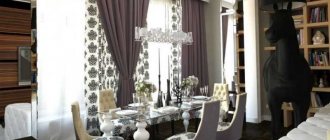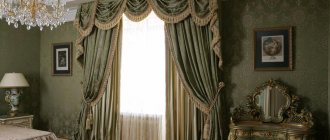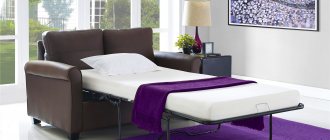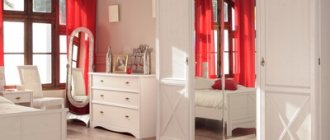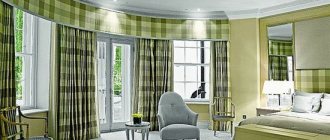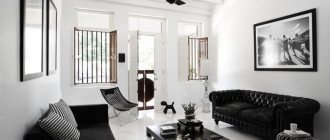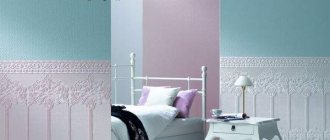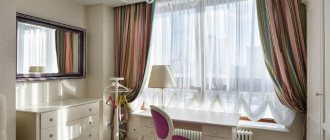Repair and decoration
04/08/2018 Anastasia Prozheva
In order to properly decorate the window decoration, you can use special accessories. Ready-made and homemade curtain tassels are especially popular. Original decorative elements not only bring freshness and unique style to a bland and familiar interior, but also help give the curtains the desired shape. A variety of units and auxiliary parts decorating the tassels allow you to decorate the room in accordance with the latest trends in design art or its traditional canons. Attractive curtain accessories, repeated on pillows or other furnishings, will ensure a harmonious combination of all decorative elements.
What are curtain tassels
The use of tassels for curtains began in the days of Ancient Rome. In its simplest form, it is a bundle of threads tied with ribbon or braid. The widespread use of tassels as a decorative element began in the 18th century. With their help, not only curtains were finished, but also clothes, furniture, and shoes. The range of materials from which brushes were made has also expanded significantly. The most popular were silk, wool, and cotton accessories.
Decorating with brushes has a rich history dating back to the distant past.
Additional Information. Tassels look especially impressive against the backdrop of solid curtains made of heavy fabrics. If the design of the room tends towards minimalism, and the window opening is covered with a translucent curtain, then the use of tassels in the decoration will not be entirely appropriate.
The appearance of decorative tassels for curtains dates back to the Roman Empire, and they became extremely popular in France during the Renaissance.
What are they?
The variety of types of curtain tiebacks, from the simplest fabric ones to complex rigid shaped products, is amazing. To choose the appropriate option, you need to mentally imagine what the model you like will look like in a specific place.
Conventionally, they can be divided into three groups:
- Rigid holders manufactured in mass production.
- Fabric products included with curtains.
- Unique accessories, made to order or independently.
Let's look at the most popular models and find out in which cases they are most appropriate.
Static metal
Original holders for curtains and in the form of door handles - structures fixed to the wall, into which the fabric is tucked. They can be of a simple form, in the form of a thick steel rod bent like a long hook, or they can be exquisite works of design art.
From curtain fabric
Fabric holders are purchased complete with ready-made curtains or ordered when sewing them. The standard double-sided “banana” model has a plastic lining inside, thanks to which it holds its shape and beautifully “hugs” the curtain. Blocks are punched at the ends of the “banana” or loops are sewn on, by which it is hung on a hook for mounting on the wall.
Hairpins
Cloth clips made of metal, plastic or wood differ from similar hair accessories only in size. They must match the fabric in density. Light tulle curtains are best suited with small, elegant pins; curtains made of thick fabrics will need to choose large items. Hairpins are not suitable for heavy curtains; metal holders or fabric “banana” tiebacks are more appropriate here.
Kanzashi
By design, tiebacks for kanzashi curtains can be pins, bananas, or strips of fabric. They are distinguished from other models by their satin decor, made using the Japanese Hana kanzashi technique. Such DIY decorations are the perfect way to beautifully drape fabric. Many handmade craftsmen specialize in their production.
Hana kanzashi - hairpins with silk flowers. They are created from squares of silk using the folding technique. Each square, rolled with tongs, turns into a flower petal. Petals are attached to a base to create whole flowers, or a sequence of flowers.
From foamiran
Like kanzashi, foamiran curtain tiebacks differ from other models not in design, but in special decorations. Magnificent flowers bloom magnificently on them, made by the hands of experienced craftswomen, almost indistinguishable from real ones.
Foamiran is a decorative foam material used in various types of needlework. It has other names: plastic suede, foam rubber, revelour, EVA foam.
Toys
Cute toys made of felt or plush, hugging curtains - the perfect design for curtain tiebacks in a nursery. They can be draped over the fabric, holding it with long legs tied in a knot, a tail into which a wire is inserted, sewn onto a strip for curtains made of satin ribbon, attached to magnetic holders, buttons.
Another fashionable variety today - cute fairies, ballerinas, tilde dolls have become a new breath in window design not only for children's rooms, but also in living rooms, as well as when decorating windows in children's cafes.
Accessories of complex shapes, bright colors, decorated with shiny fittings are suitable for plain-dyed curtains. For curtains made of printed fabric with a complex pattern, it is better to use simple tiebacks made of the same fabric or cords with tassels.
Cutlery
Stylish curtain holders for the kitchen are made from ordinary cutlery: forks, spoons, cups. To make them, just bend a fork or spoon and attach them to the wall, and cut out the bottom of the cups and hang them by the handles on hooks attached to the wall. Metal devices are able to hold thick curtains. Porcelain and earthenware cups can only hold tulle with light curtains.
With brushes
Multi-colored twisted cords with tassels are a noble status decoration. They look especially good on exquisite luxury fabrics: brocade, velvet, velor, thick silk. Draping heavy fabric with them is easy - just tie it like a belt in the right place. Often such curtains are monophonic and rich in color, and cords enliven their monotony.
To make the draperies look harmonious, the fittings must be selected in accordance with the status of the curtains. Luxurious curtains, “belted” with cheap cords, will look more than modest, and light flying curtains accompanied by heavy ropes with massive lush tassels will look tasteless.
Magnets
Models for curtains with magnets are an ideal option for attaching lightweight fabrics. Sheathed magnets (from funny plastic smiley faces to semi-precious stones) are sewn onto the ends of clips made from ribbons, decorative cables or twisted cords. The most popular magnets for curtains are metal or plastic products of simple geometric shapes (round, oval, diamond-shaped), plain, with a pattern, decorated with rhinestones or covered with fabric.
From beads
Beaded curtain tiebacks are suitable for plain or pale-patterned curtains in the bedroom and living room. They look elegant and create a chamber, peaceful atmosphere. To create tiebacks for curtains from beads, you can take ready-made jewelry or assemble them yourself, using not only beads, but also rhinestones, beads, all kinds of decorative chains that are in harmony in texture and color with the design of the room.
Macrame
Macrame is a popular type of needlework, an applied art based on the knot weaving technique. Curtains with tiebacks made using the macrame technique look very original; they are capable of gathering dense, heavy fabric, but they also look great on light curtains with a successful design.
From scrap materials
It is not easy to list everything from which they are made. The materials used are ropes, ribbons, twine, braid, yarn, scraps of fabric, old jewelry, ties, belts, belts, candlesticks, computer disks. Even plastic bottles can be used, because they can be covered with fabric or tied. The choice depends only on the imagination of the master and on what he has at hand.
The use of improvised materials makes it possible to bring to life seemingly crazy design ideas and realize unspent creative potential. A small detail in the form of an unusual or simply beautiful holder or a bright magnetic curtain tie often becomes an accent and makes the interior special and not boring.
Varieties
Depending on the place and method of attachment, the brushes can:
- fixed directly on the canvas;
- sew evenly along the edge of the curtain, creating an original edging;
- used as grabs.
The last option is especially popular today. Modern designers very often use tassels for curtains. With their help, curtains are finished both in small apartments and in huge halls for holding public events. Very often they are fixed using magnetic latches, which is very convenient and practical. In some cases, decorative brushes are additionally decorated with beads, plastic, glass and metal elements.
The decorative item is intended for decorating lambrequins and curtains. An accessory can also be a self-sufficient element in the design of a room.
Additional Information. In ancient times, in rich houses, brushes were decorated with semi-precious and precious stones, emphasizing the status and wealth of the owner.
Variety of models and materials
Beaded kutas is a bright accessory for those who want to create an unusual interior.
The abundance of types and colors of accessories for curtains presented in the trade is amazing. As in the time of the kings, today kutas are made from tapestry threads and viscose, twisted, mixed, and artificial threads. If earlier they were decorated with precious stones, now they have been replaced by Swarovski stones, beads, plastic and glass beads, which decorate brushes very beautifully. They are decorated with lurex threads, silver or gold monofilaments, beaded mesh, knots and macrame weaving. This accessory is often complemented with flowers, bows, and butterflies. In a children's room, it is appropriate to use small soft toys in the shape of animals as decoration for tiebacks with tassels.
By choosing one or another type of cutas, you can emphasize the functionality of the room . For the bedroom, accessories are selected to match the curtains, which allows you to create coziness and a comfortable environment. Attaching massive tassels to the curtains in the living room creates a feeling of celebration and solemnity. Children's enthusiasm and gaiety will be created by patterns with butterflies and soft silhouettes of animals in the children's room.
Related article: Recommendations on how to glue vinyl wallpaper on non-woven backing
Despite the large selection of curtain tassels on sale, many craftswomen make this accessory themselves. For this purpose, you need to purchase a gold-plated or silver ready-made cord (it is better to choose it to match the material for the curtains), beads of different sizes and colors, metal wire up to 2 mm thick, 2.5 m long.
First, bead pendants are prepared. Cut half a meter of wire and put a large bead on it, twisting the wire in the middle, making 2 turns. Medium beads are put on both ends together, small beads are strung on different parts of the wire.
The resulting suspension is secured with the ends of the wire to the bundle. The ends are hidden in the cord. In the same way, several pendants of different lengths are made. There can be up to 6 pendants in total. All of them are individually attached to a cord. The rest of the wire is cut off. The cord over the large bead is tied in a beautiful knot. The resulting brush is fixed on the wall, tucking the curtain fabric into it in beautiful folds.
How to choose the right brushes
When choosing decorative tassels for curtains, there are several factors to consider. First of all, you need to start from the accents that the brushes should highlight. Their use is justified if necessary:
- make a plain curtain brighter and more noticeable;
- beautifully fix the folds on the curtain;
- stretch the canvas, making its lower part heavier;
- highlight the texture of the fabric used;
- fix the heavy curtain.
In modern design, decoration with such accessories is possible in various styles, but they are more harmoniously combined with the classics - Art Deco or Baroque.
The safest option is to use brushes of the same tone as the curtain. This allows you to create a single image of window design. The use of tassels on curtains and decorative pillows fits very well into the design of a bedroom or living room.
The interior contains notes of luxury and elegance, and the use of tassels will become a symbol of wealth and noble status.
An ever-fashionable accessory
A variety of brushes allows you to choose the right accessory for any interior and budget.
Curtain tassels are made in the old-fashioned manner, like a bunch of threads tied in the middle, or they can be newfangled elements with bugles, crystals, or accessories decorated with bright balls and beaded threads. The materials for their manufacture can be:
- organza;
- cotton, wool or artificial threads.
Brushes in the interior of the house have been known since very distant times; they are also called kutas. They will add originality and attractiveness to curtains and curtains made from the simplest material. The following threads are used in different variations:
- sewn to a swag or lambrequin;
- the edges of the curtains are trimmed with braid with small tassels;
- tied with a beautiful knot in the form of a tie;
- are decor for pillows.
A brush or cutas, which is used to decorate textiles in a home, affects the character of the interior and updates it.
With its help, it is easy to dilute the monotony of the pattern on the fabric, you can accentuate and highlight the main color of the curtain, add festiveness and solemnity to the interior. This decorative element is purchased in the same color scheme as the curtains or in a contrasting color so that the curtains stand out and attract attention.
Related article: Method of growing seedlings at home
Most often, curtain tassels are used in classical, Roman or Greek style designs. To decorate window and door openings in the Rococo or Empire style, large tassels or fringe with pompoms and tassels must be used.
How to make curtain tassels with your own hands
If desired, you can make original tassels for curtains yourself. There are several ways to create brushes of different sizes. One of the most common is the method using a wooden ball. Its diameter is selected depending on the size of the brush we want to get.
Making a brush with your own hands is not difficult. It can be made from the simplest materials that you can always find at home.
A through diametrical hole is drilled in the ball, through which it is completely braided with thread of the selected color. A wooden or plastic ring, also braided with thread, is glued to the ball above the hole. This is the top part of the brush.
To obtain the lower part (skirt), you need to wind pre-selected threads (can be of different colors) onto a cardboard rectangle, the height of which is twice the diameter of the ball. The thicker the winding, the more fluffy the skirt will be. After removing the cardboard, the upper part is pulled together with braid, and the lower part is cut with scissors.
Purchased models all look the same, but a hand-made brush will be unique.
At the final stage, you need to connect the ball and the skirt. To do this, the braid with the upper edge of the skirt is pulled through the hole in the ball and secured with a cord. Additionally, you can decorate the resulting accessory with beads or multi-colored crumbs.
Additional Information. If desired, you can simplify the process of making a brush (without a ball and ring). To do this, the yarn is wound on a cardboard base, the lower part is cut, and a brush head is formed in the upper part, tightly tying the skein at a distance of about 1 cm from the edge.
Such decorative accessories are presented in various designs, for example, they can vary depending on thickness, shape, color palette, texture.
Mounting options
After the curtain decorations have been selected, they need to be tied beautifully. There are several ways of such fastenings:
- the easiest way is to attach the cord to a special hook in the wall, and tie the elements finished with tassels in a double knot;
- two different cords, attached to a hook, wrap the curtains in their parts decorated with tassels and tie them into a knot. If the resulting knot does not look very neat, the junction can be decorated with a brooch, a flower, or wrapped with braid. This option has excellent decorative qualities, but if you want to remove the pickup, you will need to dismantle this entire structure;
- The macrame technique has always been distinguished by its beauty and style; the tiebacks created using this knotting technique are unique;
- According to the rules of geometry, symmetrically located canvases are tied at an equal distance from the window. This solution is standard for classic curtains;
- asymmetrical fastening of tiebacks involves fixing one panel at the level of the window sill, and the second above or below this level. This technique can visually increase the space;
- if two windows are decorated, which are located next to each other, a layer of curtains should be made between them, while on different extreme sides of the windows the canvases are tied at the same level.
Rules for using curtain tassels
Designers advise following several rules when using brushes:
- Brushes look impressive on simple plain curtains, becoming the highlight of the window opening design.
- If the curtain itself looks beautiful and rich, then it is absolutely not necessary to use additional decorative elements. They can create the effect of clutter and bad taste.
- Curtain tassels should not be placed lower than 100 cm from the floor.
- If the tiebacks are on symmetrical curtains of one window, then it is extremely important that the tassels are at the same height.
When decorating a window, not only the appearance of the brushes is important, but also how they are tied. The most common option is to attach a double cord to the head of the brush, which will cover the curtain, and attach it to a clamp on the wall. In this case, the latch itself (hook) can, depending on the design, either be hidden under the curtain or left in plain sight. The double knot connecting two brushes also looks very original.
Textile decorative elements will help create a unique design and add a sophisticated touch to any room.
At what height should I hang it?
Curtain tiebacks can be attached to the wall at different distances from the window opening. This largely determines what the size of the window will visually appear to be. Hanged close to the opening, they will narrow it; installed at a distance, they will widen it.
When choosing a location for installing tiebacks for curtains and tulle, you need to consider the following:
- Canvases assembled at the level of the window sill, as when attached to one side, do not create a visual illusion. This method is preferable when the curtains occupy the entire wall.
- Drapery above the level of the window sill, at a distance of approximately 2/3 from the floor, visually expands the window opening. This technique is especially good in the kitchen, where it is customary to hang short curtains.
- Holders installed 25-35 cm below the level of the window sill visually make the opening narrower and higher. This method is especially relevant when the windows are decorated with heavy curtains that reach the floor or extend along the floor.
The height of the hooks depends on the effect you want to achieve: to make the ceilings higher or to expand the room, so before attaching the hooks, mentally imagine the end result.
Pros and cons of using curtain tassels in the interior
Most often, decorative tassels for curtains are used when decorating a bedroom or living room. Their use allows:
- make the room more comfortable;
- create a unique design and atmosphere in the room, especially if the brushes are made by yourself;
- give the room a touch of aristocracy;
- focus attention on the curtain, making it a key element of the interior.
It should be remembered that brushes were originally conceived as an element of the classical style. Today, the range of their applications is much wider; they are even trying to fit them into high-tech. But it is very important to capture a sense of proportion so that the brushes do not fall out of the overall concept of the room.
They must be selected based on the color palette of the interior.
A huge assortment of ready-made brushes and ideas for making them yourself allows you to choose brushes for almost any interior. However, their choice requires a serious, thoughtful approach. Therefore, if you are not 100% sure that the use of brushes will be in harmony with the overall interior, then you should not rush. It is possible that metal or plastic clamps would be more appropriate in this case.
An unusual design will bring refined, elegant and luxurious notes to the interior, showing the status of the apartment owners and their impeccable taste.
Features of grabs
In its configuration, the grab is a loop created from two ends of fabric attached to the wall. The curtains are gathered into a bun (drapery) and then strengthened with a tieback. Methods of draping fabric directly depend on its density and heaviness: along with light curves, people fell in love with wide and lush coattails.
If we consider the types of curtain fastenings, then their choice is quite wide. Tiebacks include everything that can hold the canvas in an assembled and fixed position on its side:
- laces of various thicknesses;
- braid decorated with decorative stitching;
- textile strips;
- leather straps;
- hook for picking up curtains;
- twine;
- vintage style door handles;
- floral and romantic decorative compositions;
- in the form of hairpins;
- beads, etc.
Magnetic holders, which are available in a wide range of colors and different shapes, appeared on the market relatively recently, but have already managed to interest buyers.
Depending on the material used, the grab bars can be textile, wood, metal, leather or plastic. With a creative approach, any element becomes a fabric holder: hairpins, toys, artificial flowers and butterflies sewn onto braid.
The aesthetic value of the tieback is that it can give an updated look to even old curtains, and in addition, it is an independent decorative unit.
Advantages of curtain tiebacks:
- Updating your interior with fresh and trendy touches.
- Curtains with tiebacks benefit from composition, and with the help of drapery, unique textile forms are obtained that are securely fixed.
- The opportunity to implement a variety of creative ideas in the decorative design of the room.
Also, when using holders, there is no need to constantly curtain the window, as a result of which the fabric wears out faster.
50 design options for curtains with tassels and tiebacks
The influence of textiles on the choice of holder
The heavier the fabric, the more powerful the holders should be, and the more responsible their installation is considered.
If you decide to use powerful hooks to tie up curtains, the fabric must match them: in this case, velvet, brocade, gabardine, and jacquard look harmonious. Many expensive curtains have a lining, thanks to which they last a long time and do not fade too intensely. Fabric holders in the form of braid, pins or beads are suitable for light curtains.
Textile tiebacks often match the fabric of the curtains; unobtrusive harmonious shades are acceptable. Sometimes bold color schemes are used, where bright holders act as a kind of contrasting spot, enlivening the monotonous atmosphere.
If you decide to make textile tiebacks yourself, then take into account the following nuance: expensive fabric is used for the front side, and the inner side is treated with lining for reasons of economy.
The tieback is sewn with a lining even when thin fabric such as chiffon or silk is used to attach the curtains to the wall.
Inside rooms intended for official receptions, it is not recommended to take any liberties, so the tiebacks here are made strict and monochromatic.
If the interior is rich and deliberately luxurious, then tiebacks for curtains made of gold braid, twisted cords or silk ribbons are attached.
Holders made of wood and fabric are used for literally all types of curtains - these are universal options. Metal rings and hooks are used to decorate window textiles in rooms decorated in high-tech, minimalism or art deco styles. Artificially aged hooks for curtain tiebacks look stylish.
Weightless butterflies and flowers are suitable for window decorations in a romantic girl’s room, and small soft toys, which are used as curtain mounts on the wall, perfectly complement the atmosphere of a nursery.
Installation process
Find the required mounting point. Attach the holder and mark the mounting points for the holder using a regular pencil or a small piece of tape. Using a drill, drill holes and, using a screwdriver, attach the holder with self-tapping screws.
The main rule to determine the location of the holder: measure seven times and attach only once.
But professionals in this field suggest not to rush to make a decision, but to try every type of fastener and live with it for a little while. This is the only way to choose the ideal fastening method for you. This will create an atmosphere of comfort, coziness and harmony in the room.
